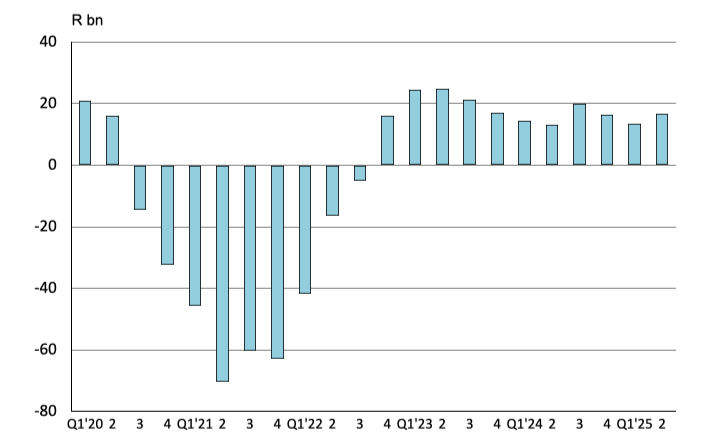Economic Update October 2025
- Dr Roelof Botha

- Nov 8
- 3 min read
Updated: 6 days ago
The downside
The proceedings of the Judicial Commission of Inquiry into Criminality, Political Interference, and Corruption in the Criminal Justice System, more commonly known as the Madlanga Commission, bear a resemblance to a horror story. To the extent that a modicum of truth exists in the revelations by the head of the country’s crime intelligence that sophisticated, organised criminal entities have infiltrated the state's crime prevention apparatus, immediate and comprehensive measures will be required to halt the decline in the country’s police service. Unless the public can be convinced that the Madlanga Commission will ultimately lead to the removal from office of persons found guilty of apparent state capture by violent criminal networks, South Africa stands to lose intellectual capital in the form of the emigration of highly skilled individuals, who are always in demand around the globe.
On the economic front, the fact that capacity utilisation in manufacturing remained lower in August 2025 than a year ago is a testament to the ongoing oversight by the Monetary Policy Committee (MPC) of the plight of South Africa’s manufacturing sector. In August, the volume of manufacturing production was more than 9% lower than in August 2019 (pre-COVID), primarily due to a lack of demand and an overvalued currency, which makes imported manufactured products relatively cheaper than local products. Lowering interest rates is the obvious remedy, but the MPC appears to be blissfully unaware of the damage it continues to inflict on the economy through its overly restrictive monetary policy approach.
The upside
Retail trade continues impressive rise
In the midst of lethargic growth for the manufacturing and wholesale sectors, consumers are doing the economy a big favour by returning to the shops in numbers, posting a real year-on-year increase in sales values of almost 4% during the second quarter of 2025. In value terms, South African shoppers spent a whopping R972 billion between January and August, with the four-quarter average reaching a record high of R380 billion.

The recent spike has positively influenced the latest data on bumper retail trade sales, as indicated by long-term insurance surrenders and lump-sum pension payments. These increases have been the result of the so-called two-pot retirement system, which commenced in the third quarter of 2024 and has led to a significant increase in retirement fund withdrawals. Little doubt exists over the positive impact of these withdrawals on the value of retail trade sales.
According to data compiled by BetterBond, the average real salary of homebuyers has increased at a healthy rate over the past four years, with total household income averaging R90,000 per month. This trend has also contributed to the recovery of retail trade sales.
The financial account of the balance of payments is in good shape
According to the Banking Association of South Africa, South Africa’s removal from the grey list of the Financial Action Task Force (FATF) at the end of October holds the prospect of improving investor confidence. It also serves as proof that the government of national unity (GNU) can deliver results in tackling the scourge of corruption that became evident during the era of state capture.

The robust performance of the financial account in the balance of payments since 2023 suggests that capital markets have always been comfortable with South Africa’s ability to address the legislative deficiencies identified by the FATF. A nod of approval was also received from capital markets, with South Africa’s ten-year bond yield continuing its downward trend and the rand having strengthened by more than 9% against the US dollar since the beginning of the year (as of 31 October).
Credit rating upgrade on the cards
Speculation is rife that South African bonds may soon receive a credit rating upgrade, as alluded to in a note published by the Bank of America, which referred to the current positive outlook by S&P Global Ratings for South Africa’s local currency debt (albeit still at a sub-investment grade level). The next overview of South Africa’s macroeconomic and fiscal disposition by the ratings agency will likely be influenced by sound prospects for higher growth in 2025 and 2026, significant increases in precious metal prices, and improvements in harbour efficiency. The removal from the FATF grey list and signs that the coalition government is starting to implement economic and fiscal reforms, whilst also improving the country’s logistics, will also play a role in the decision by S&P Global.

On Balance, by Dr Roelof Botha, deliberately emphasises positive news, which often highlights the resilience of the South African economy and the immense scope for new business opportunities.









Comments